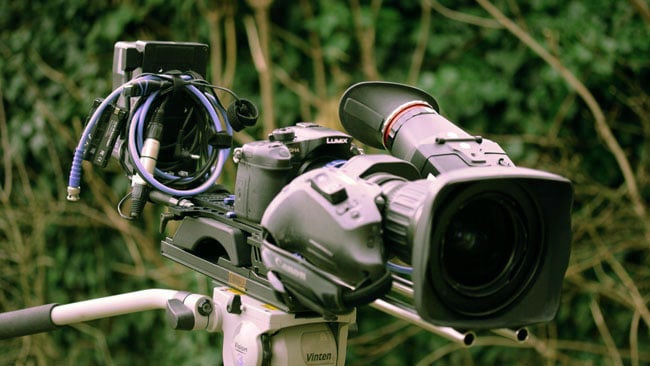
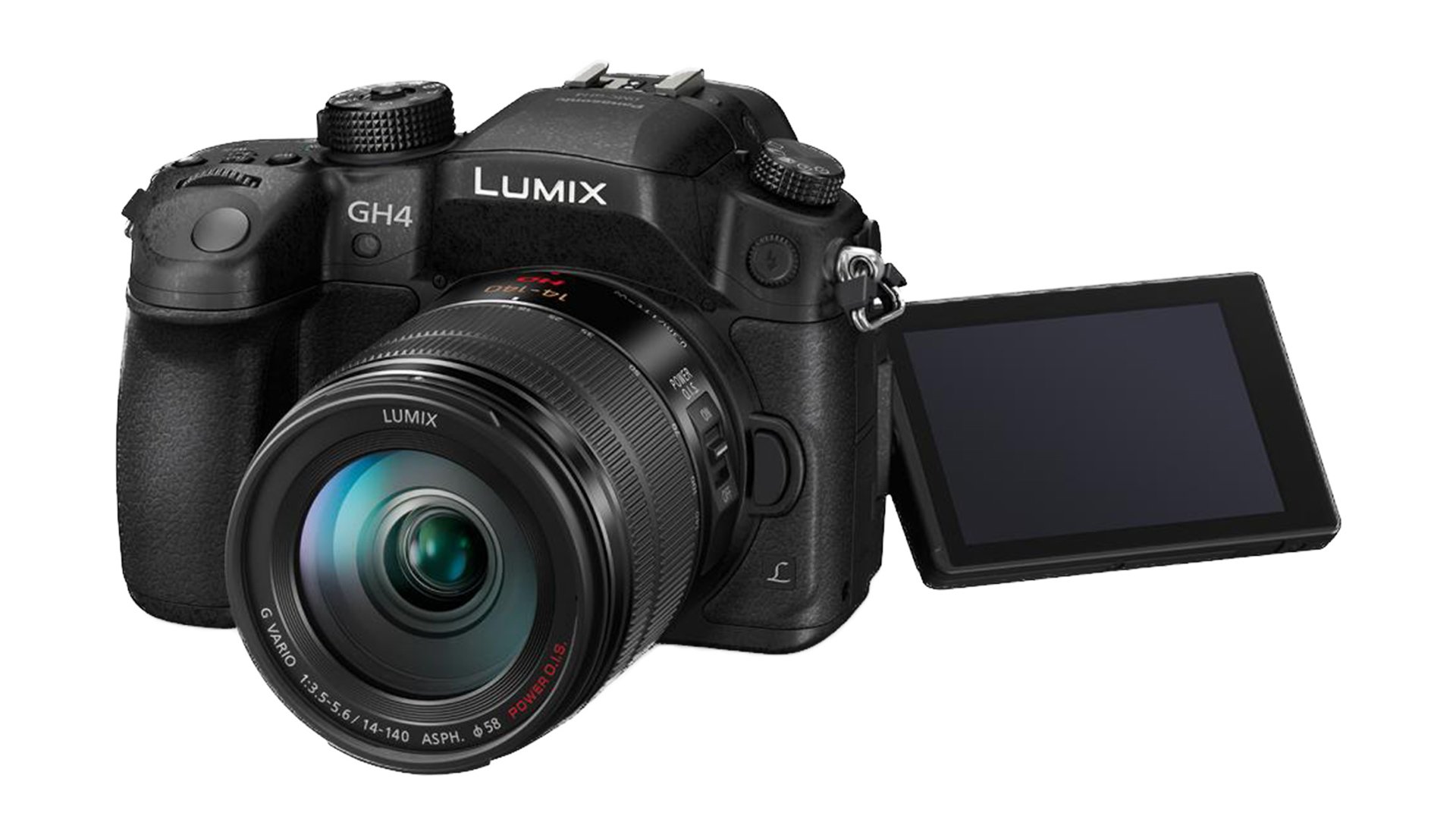
If you are an aspiring filmmaking with no money, how on earth can you afford a camera that will produce release worthy pictures? Phil Rhodes raids the last coins in his piggy bank to offer three good examples of cameras to suit extremely threadbare budgets.
Filmmaking is one of the most expensive artforms, which makes life tough if you're a student with big ideas and no gear. That's probably better than being a trust-fund scion with, as the saying goes, all the gear and no idea, but at some point, a filmmaker needs something to shoot on. It's almost redundant to point out that cameras capable of cinema quality have never been more affordable, but what's the situation if we're really short on cash? Like, a few hundred pounds short of cash?
A documentarian will have very different needs to someone who endlessly shoots music videos, and if we're absolutely demanding 4K, high frame rate or other, the game changes slightly. Because of all those concerns, nothing we could say will suit everyone, but let's have a look what we can achieve for – let's say – under £1000, in early 2019.
The basics - Canon EOS-50D (£200)
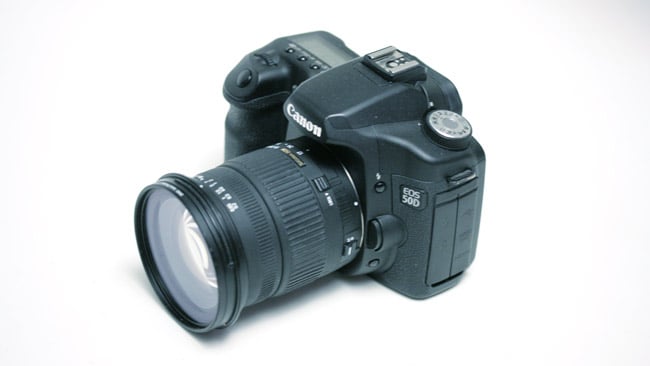
The mighty Canon EOS-50D, possibly the cheapest route to raw video
So you want high definition raw from a big chip behind affordable lenses recorded onto low-cost media. In short, you want the moon on a stick, but it is possible.
OK, this is something of a novelty entry, but the Canon EOS-50D was cheap when it was discussed way back in 2013 and it's probably cheaper now. It's the only device ever to have been launched as not a video camera, and made into a video camera by third-party software development. It's a Canon, so it's well-built and reliable, and Canon have so far not shown a tendency to disown people who have run third party code. Magic Lantern is not known to regularly cause serious reliability problems either.
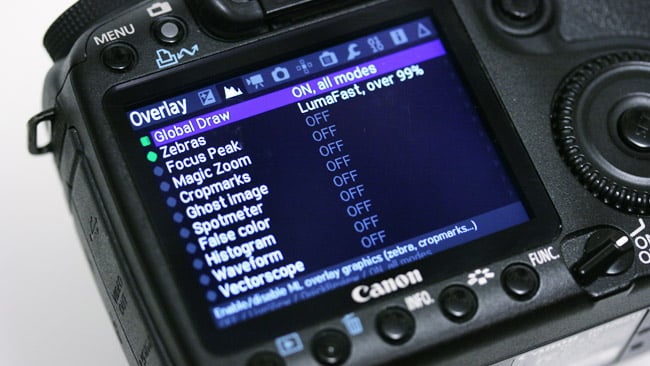
While it's most famous for the raw video capability, Magic Lantern does a lot more things besides
There are a few things to be aware of. The technically-best raw mode uses a 1:1 pixel crop of the sensor, which completely avoids any aliasing, but turns your APS-C (and thus roughly super-35mm) camera into effectively a super-8 camera. That's not necessarily a dealbreaker, since – as we've frequently observed – the modern obsession with shallow depth of field is often not easy to deal with and is increasingly tired as an aesthetic anyway. Nevertheless, a chip that small demands short focal length lenses, and we can't even put a speed-booster style adapter on an EF mount to recover some field of view. Use a wider sensor area and the aliasing comes back.
Viewfinding in many of the raw modes is extremely clunky, playback performance is mixed, external monitoring involves lots of fixed overlays and regardless the inconveniences, it's still uncompressed HD raw and the files are vast. HD raw for £200 is therefore possible, but is too riven with issues for day to day work on fast-moving shoots.
The conventional H.264 modes work fine, though the 50D has the aliasing issues of any Canon DSLR of its vintage. Mosaic Engineering still offer the VAF-50D antialiasing filter but it's not clear how effective that really is; the results tend to be sub-HD given how much softening is required to overcome the aliasing. There are no audio recording facilities, so dual system sound is required.
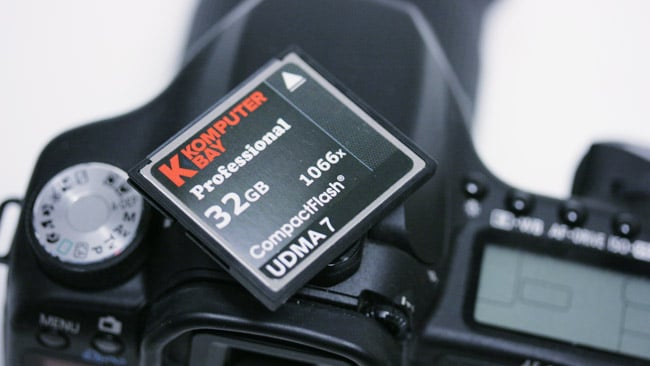
Large, fast compactflash cards are a necessity, although this will doubtless seem insignificantly small to anyone reading in 2021
It's possible to go up a little in price and get a slightly more recent (but still used and affordable) Canon which was actually intended to shoot video; this might cost as little as £300 and would provide audio. The reason to stick with Canon would usually be the need to control EF or EF-S lenses – and they do make nice pictures. The H.264 is heavily compressed and aliasing remains a problem until the more recent cameras, but within that limit it's more than good enough to demonstrate ability.
In raw mode, the 50D can look fantastic, but it's a pain. In H.264 mode it's as easy as anything else. It will struggle to get through a QC for broadcast TV or feature film work, but really, who cares about broadcast these days, Grandpa?
Going to 4K – Panasonic GH4 (£400)
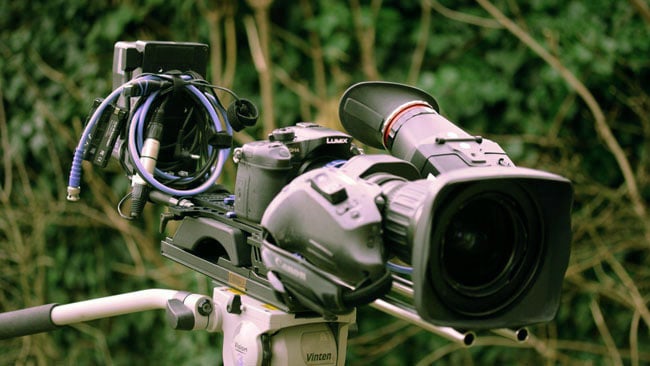
GH4 with B4-mount ENG lens
For about twice the price, it's possible to shoot 4K, and even 10-bit log with external recording. The GH4 may be cheaper to feed, since it takes SD cards, but perhaps the most crucial advantage is the shallow, micro-four-thirds lens mount which facilitates the use of more or less any lens, other than those designed for Sony's E-mount.
It's even possible to use B4-mount broadcast zooms and rig the camera into an effective, low-cost documentary camera. There's a mode that Panasonic call “ETC,” which stands for something like “extra tele-conversion” but actually means HD sensor windowing. In this mode, most B4 lenses cover with or without the extender engaged; in full-sensor mode they will tend to cover with the extender engaged, offering a very complete menu of sensor size and lens capability.
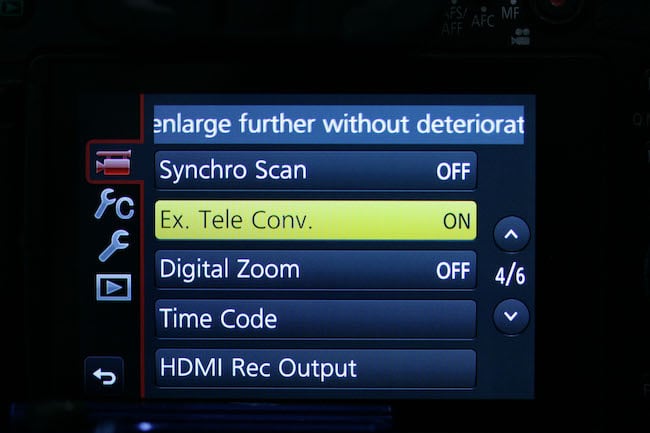
gh4 menu shows ETC sensor windowing mode
Most expanded configurations require lots of rigging to make shooting from the shoulder practical, but it can be done. In the meantime, a low-cost speed-booster clone can be added to make affordable stills lenses work even better in any sensor mode. To complete the list of upsides, the GH4 has an HDMI output capable of uncompressed 10-bit, 4K 4:2:2. The GH4 is hugely flexible and expandable and could be used in almost any kind of production
A 4K HDMI recorder capable of taking advantage of all that is, of course, an expense that'll likely exceed the cost of the camera. SSDs sufficient to record more gently-compressed 4K ProRes may easily cost as much again. External recording is really required to make the log mode useful, since trying to recover normal contrast from heavily-compressed, 8-bit internal recordings is a dubious approach at best.
There is also a price to pay for all that flexibility. It's dangerous to start quoting numbers, but some tests have shown the GH4 achieving perhaps eleven stops of dynamic range, around a stop less than the 5D Mk. III which was two years old at the time of the GH4's launch. It's a natural consequence of putting a 4K grid of pixels on a micro-four-thirds sensor, which is what gives the camera all that flexibility, but GH4s do not make Canon pictures. Comparatively, a Sony A7s, while vastly less flexible, has the same resolution on a vast sensor creating huge photosites, and clocks in at an Alexa-competitive 14 stops.
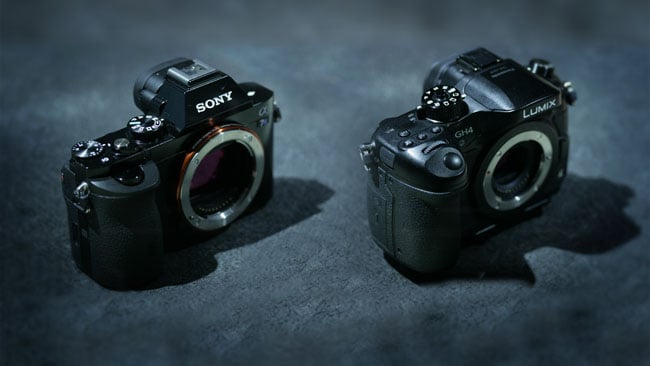
Sony A7S and Panasonic GH4 without lenses
Nearly 11 stops is not a dealbreaker. The Viper camera, an early 2/3” HD digital cinematography device, had similar capability and was used to shoot many beautiful films, but the GH series might be described as making documentary pictures more than they make cinema pictures, at least straight out of the camera. With Resolve, much can be achieved.
The high end of the low end – Sony NEX-FS700 or possibly PMW-F3 (£999)
At the time of writing, there was a Sony PMW-F3 on the UK eBay for £999, scraping in just barely under our thousand-pound limit. What's more, that particular F3 had the RGB upgrade, making high quality recordings, without colour subsampling, possible. The F3 boasts the sturdy FZ mount which is compatible with literally anything via adaptation. At one time, the F3 was a very popular freelancer's camera and much good work was done on it; it is a properly-built professional camera and we've talked positively about it in the past.
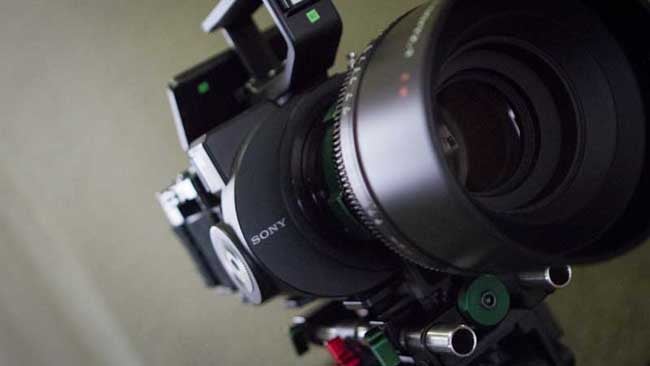
An FS700 in its natural habitat, hiding behind a massive cinema lens
The thing is, it's possible to get an FS700 for very similar money. The FS700 does a lot, lot more: it shoots high frame rate, and with upgrades it can shoot 4K raw. It's among the most upgradeable video cameras ever made, making the F3 a tough thing to recommend unless you're seriously into the better build and slightly nicer colour rendering, at the cost of 4K and high frame rate.
Both cameras use an awkward layout with the viewfinder (in the case of the F3) or popup display (in the case of the FS700) centred at the back. They will require rigging and perhaps a third-party viewfinder for better handling. F3s are often they're described as “PL mount cameras,” but really they use Sony's FZ mount which seems to have been designed as a basis for adaptation. The E mount on the FS700 is almost as flexible, being very shallow, but certainly nothing like as heavily built.
Likewise, both cameras will require external recording for best results. The F3 tops out at a miserly 35Mbps, while the FS700 claims up to 28, both recording to SD cards. Either can be straightforwardly recorded to standard external recorders, though the high frame rate modes on the FS700 may require a more capable external recorder that may not be very cheap.
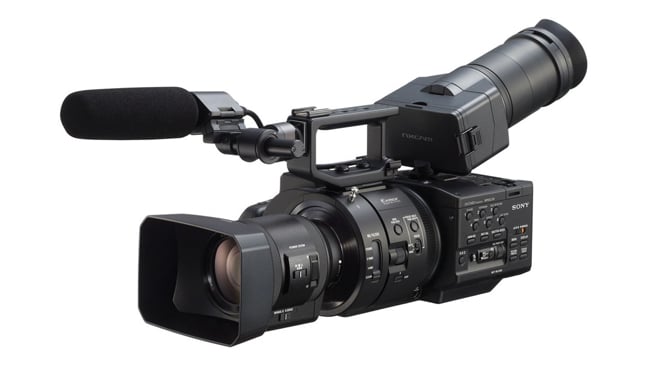
FS700
Both of these cameras could, at one time, be upgraded. The F3 grew 3-gigabit SDI outputs for 4:4:4 colour, though there was always some question over whether the three-and-a-bit megapixel sensor could really be said to resolve true 4:4:4 colour. The FS700 needed to go back to Sony for an internal firmware update to support more recent recording options. Cameras with these upgrades will be more expensive – an NEX-FS700R and some PMW-F3L will break our self-imposed £1000 budget, but it isn't clear that the upgrade will ever be available from Sony again, so if you need it, buy one that has it.
And be careful
One of the cameras discovered in the process of researching this piece was being sold as “Black majic pocket cinema camera.” (spelling intentional!) Now, the Pocket is a fantastic little camera, enjoying many of the advantages of the GH4 plus rather bigger photosites, and was only just pushed out of the running by the cheaper, 4K-capable Panasonic.
However, while we shouldn't be uncharitable to someone who might be a user of English as a second language, it's probably best to prioritise sellers who know how to spell the name of the thing they're selling. And none of these cameras are young, though they have all – particularly the seminal FS700 with its massive upgrade path - remained useful far longer than most cameras do.
Tags: Production


Comments